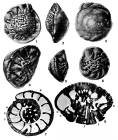Foraminifera taxon details
Medocia Parvati, 1971 †
722395 (urn:lsid:marinespecies.org:taxname:722395)
accepted
Genus
Medocia blayensis Parvati, 1971 † (type by original designation)
marine, brackish, fresh, terrestrial
fossil only
feminine
Parvati, S. (1971). A study of some rotaliid Foraminifera. <em>Koninklijke Nederlandse Akademie van Wetenschappen Proceedings, Series B.</em> 74(1):1–26. [details]
Hayward, B.W.; Le Coze, F.; Vachard, D.; Gross, O. (2024). World Foraminifera Database. Medocia Parvati, 1971 †. Accessed at: https://www.marinespecies.org/foraminifera/aphia.php?p=taxdetails&id=722395 on 2024-04-24
Date
action
by
original description
Parvati, S. (1971). A study of some rotaliid Foraminifera. <em>Koninklijke Nederlandse Akademie van Wetenschappen Proceedings, Series B.</em> 74(1):1–26. [details]
basis of record Loeblich, A. R.; Tappan, H. (1987). Foraminiferal Genera and their Classification. Van Nostrand Reinhold Company, New York. 970pp., available online at https://books.google.pt/books?id=n_BqCQAAQBAJ [details] Available for editors [request]
[request]
basis of record Loeblich, A. R.; Tappan, H. (1987). Foraminiferal Genera and their Classification. Van Nostrand Reinhold Company, New York. 970pp., available online at https://books.google.pt/books?id=n_BqCQAAQBAJ [details] Available for editors
From editor or global species database
Diagnosis Test lenticular, trochospiral, spiral side strongly convex, septa doubled by addition of septal flap leaving septal passages between the simple sutural fissures and the overlying perforate sutural lobes formed as an extension of the chambers on the umbilical side, alternate laminae from sutural lobes and secondary deposits produce an umbilical mass with labyrinthic grooves, pierced by vertical tubular funnels that connect earlier parts of the spiral canal directly to the surface of the umbilical side, spiral canal lies between the umbilical mass and the umbilical flaps and is covered by the sutural lobes, peripheral margin with imperforate band; wall calcareous, perforate, laminated, with thick lamellar wall on the spiral side as in Rotalia; aperture an interiomarginal slit, extending from the umbilical mass nearly to the periphery, partially covered by a large imperforate lip that is separated from the apertural face by a passage, both areal and interiomarginal intercameral foramina present. M. Eocene (Lutetian); France. (Loeblich & Tappan, 1987, Foraminiferal Genera and Their Classification) [details]
